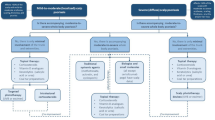Abstract
Topical therapy is one of the foundations of dermatology. The vehicles used to deliver topical therapy have considerable impact on efficacy. The vehicle can have direct effects on disease; it can impact the delivery of the active drug, and its characteristics affect patient compliance. While the physical chemistry of vehicles has been studied in great detail, there has been very little study of patients’ preferences for different vehicles and even less on the effect of these preferences on patient compliance. Such study is essential, as noncompliance with topical therapy is very common, and likely impacts the response to topical therapy observed in clinical practice. This manuscript discusses information on patients’ preferences for different vehicles, focussing on the treatment of scalp psoriasis. Significant vehicle characteristics such as ease or difficulty of use, messiness, odors, and staining are recognized to affect patients’ preferences. An instrument based on these characteristics has been used to compare patients’ preferences for different vehicles. Patients with psoriasis generally prefer less messy vehicles, such as foam and solution preparations, to traditional cream and ointment vehicles. These preferences have the potential to impact patient compliance. Studies directly measuring patient compliance have not yet been performed. In conclusion, the choice of vehicles impacts both the potency of the medication and patients’ acceptance of the treatment. Actual effects of different vehicles on compliance are important but have not yet been adequately studied.
Similar content being viewed by others
Notes
Use of tradenames is for product identification only and does not imply endorsement.
References
Ehmann CW. Dermatological drug development. Arch Dermatol 1988; 124 (6): 950–951
Stoughton RB. Percutaneous absorption of drugs. Annu Rev Pharmacol Toxicol 1989; 29: 55–69
McMichael A, Feldman SR. How to treat common scalp dermatoses. Skin Aging 1999; 7: 44–52
Franz TJ, Parsell DA, Myers JA, et al. Clobetasol propionate foam 0.05 %: a novel vehicle with enhanced delivery. Int J Dermatol 2000; 39: 521–538
Olsen EA, Cram DL, Ellis CN, et al. A double-blind, vehicle-controlled study of clobetasol propionate 0.0 5% (Temovate) scalp application in the treatment of moderate to severe scalp psoriasis. J Am Acad Dermatol 1991; 24: 443–447
Katz HI, Lindholm JS, Weiss JS, et al. Efficacy and safety of twice-daily augmented betamethasone dipropionate lotion versus clobetasol propionate solution in patients with moderate-to-severe scalp psoriasis. Clin Ther 1995; 17: 390–401
Rapp SR, Exum ML, Reboussin DM, et al. The physical, psychological and social impact of psoriasis. J Health Psychol 1997; 2: 525–537
Rapp SR, Feldman SR, Fleischer Jr AB, et al. Health related quality of life in psoriasis: a biopsychosocial model and measures. In: Rajagopalan R, Sherertz EF, Anderson R. Care management of skin diseases: life quality and economic impact. New York: Marcel Dekker Inc, 1998: 125-45
Housman TS, Mellen B, Rapp SR, et al. Psoriasis patients prefer solution and foam vehicles: a quantitative assessment of vehicle preference. Cutis 2002; 70 (6): 327–332
Richards HL, Fortune DG, O’Sullivan TM, et al. Patients with psoriasis and their compliance with medication. J Am Acad Dermatol 1999; 41: 581–583
Balkrishnan R, Carroll CL, Camacho FT, et al. Electronic monitoring of medication adherence in skin disease: results of a pilot study in psoriasis. J Am Acad Dermatol. In press
Herz G, Blum G, Yawalkar S. Halobetasol propionate cream by day and halobetasol propionate ointment at night for the treatment of pediatric patients with chronic, localized plaque psoriasis and atopic dermatitis. J Am Acad Dermatol 1991 Dec; 25 (6 Pt 2): 1166–1169
George YA, Ravis SM, Gottlieb J, et al. Betamethasone Valerate 0.12 % in Foam Vehicle for Scalp Seborrheic Dermatitis in African Americans. Cosmet Dermatol 2002; 15 (7): 23–27
Housman TS, McMichael AJ, Mellen BG, et al. Use of 0.12 % betamethasone valerate foam vs 0.0 1% fluocinolone acetonide topical oil to treat scalp psoriasis: quantitative assessment of patient preference and treatment efficacy. Cosmet Dermatol 2002; 15 (11): 27–30
Bikowski J. The use of therapeutic moisturizers in various dermatologic disorders. Cutis 2001; 68 (5 Suppl.): 3–11
Stein LF, Sherr A, Solodkina G, et al. Betamethasone valerate foam for treatment of nonscalp psoriasis. J Cutan Med Surg 2001; 5: 303–307
Feldman SR, Ravis SM, Fleischer Jr AB, et al. Betamethasone valerate in foam vehicle is effective with both daily and twice a day dosing: a single-blind, open-label study in the treatment of scalp psoriasis. J Cutan Med Surg 2001; 5: 386–389
Acknowledgements
Dr Feldman has received grant support from Connetics Corporation.
Author information
Authors and Affiliations
Rights and permissions
About this article
Cite this article
Feldman, S.R., Housman, T.S. Patients’ Vehicle Preference for Corticosteroid Treatments of Scalp Psoriasis. Am J Clin Dermatol 4, 221–224 (2003). https://doi.org/10.2165/00128071-200304040-00001
Published:
Issue Date:
DOI: https://doi.org/10.2165/00128071-200304040-00001




